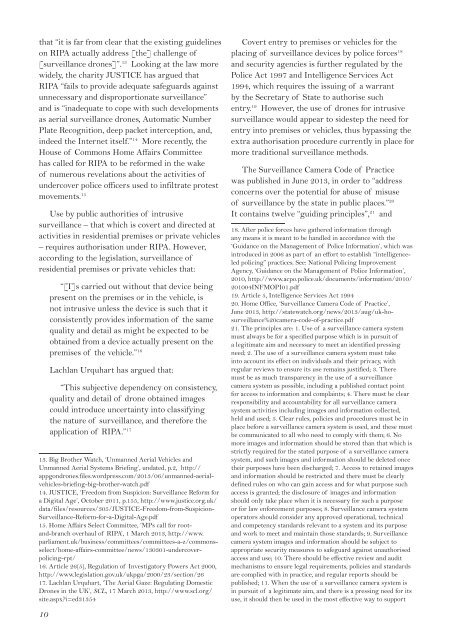Create successful ePaper yourself
Turn your PDF publications into a flip-book with our unique Google optimized e-Paper software.
that “it is far from clear that the existing guidelines<br />
on RIPA actually address [the] challenge of<br />
[surveillance drones]”. 13 Looking at the law more<br />
widely, the charity JUSTICE has argued that<br />
RIPA “fails to provide adequate safeguards against<br />
unnecessary and disproportionate surveillance”<br />
and is “inadequate to cope with such developments<br />
as aerial surveillance drones, Automatic Number<br />
Plate Recognition, deep packet interception, and,<br />
indeed the Internet itself.” 14 More recently, the<br />
House of Commons Home Affairs Committee<br />
has called for RIPA to be reformed in the wake<br />
of numerous revelations about the activities of<br />
undercover police officers used to infiltrate protest<br />
movements. 15<br />
Use by public authorities of intrusive<br />
surveillance – that which is covert and directed at<br />
activities in residential premises or private vehicles<br />
– requires authorisation under RIPA. However,<br />
according to the legislation, surveillance of<br />
residential premises or private vehicles that:<br />
“[I]s carried out without that device being<br />
present on the premises or in the vehicle, is<br />
not intrusive unless the device is such that it<br />
consistently provides information of the same<br />
quality and detail as might be expected to be<br />
obtained from a device actually present on the<br />
premises of the vehicle.” 16<br />
Lachlan Urquhart has argued that:<br />
“This subjective dependency on consistency,<br />
quality and detail of drone obtained images<br />
could introduce uncertainty into classifying<br />
the nature of surveillance, and therefore the<br />
application of RIPA.” 17<br />
13. Big Brother Watch, ‘Unmanned Aerial Vehicles and<br />
Unmanned Aerial Systems Briefing’, undated, p.2, http://<br />
appgondrones.files.wordpress.com/2013/06/unmanned-aerialvehicles-briefing-big-brother-watch.pdf<br />
14. JUSTICE, ‘Freedom from Suspicion: Surveillance Reform for<br />
a Digital Age’, October 2011, p.155, http://www.justice.org.uk/<br />
data/files/resources/305/JUSTICE-Freedom-from-Suspicion-<br />
Surveillance-Reform-for-a-Digital-Age.pdf<br />
15. Home Affairs Select Committee, ‘MPs call for rootand-branch<br />
overhaul of RIPA’, 1 March 2013, http://www.<br />
parliament.uk/business/committees/committees-a-z/commonsselect/home-affairs-committee/news/130301-undercoverpolicing-rpt/<br />
16. Article 26(5), Regulation of Investigatory Powers Act 2000,<br />
http://www.legislation.gov.uk/ukpga/2000/23/section/26<br />
17. Lachlan Urquhart, ‘The Aerial Gaze: Regulating Domestic<br />
Drones in the UK’, SCL, 17 March 2013, http://www.scl.org/<br />
site.aspx?i=ed31354<br />
10<br />
Covert entry to premises or vehicles for the<br />
placing of surveillance devices by police forces 18<br />
and security agencies is further regulated by the<br />
Police Act 1997 and Intelligence Services Act<br />
1994, which requires the issuing of a warrant<br />
by the Secretary of State to authorise such<br />
entry. 19 However, the use of drones for intrusive<br />
surveillance would appear to sidestep the need for<br />
entry into premises or vehicles, thus bypassing the<br />
extra authorisation procedure currently in place for<br />
more traditional surveillance methods.<br />
The Surveillance Camera Code of Practice<br />
was published in June 2013, in order to “address<br />
concerns over the potential for abuse of misuse<br />
of surveillance by the state in public places.” 20<br />
It contains twelve “guiding principles”, 21 and<br />
18. After police forces have gathered information through<br />
any means it is meant to be handled in accordance with the<br />
‘Guidance on the Management of Police Information’, which was<br />
introduced in 2006 as part of an effort to establish “intelligenceled<br />
policing” practices. See: National Policing Improvement<br />
Agency, ‘Guidance on the Management of Police Information’,<br />
2010, http://www.acpo.police.uk/documents/information/2010/<br />
201004INFMOPI01.pdf<br />
19. Article 5, Intelligence Services Act 1994<br />
20. Home Office, ‘Surveillance Camera Code of Practice’,<br />
June 2013, http://statewatch.org/news/2013/aug/uk-hosurveillance%20camera-code-of-practice.pdf<br />
21. The principles are: 1. Use of a surveillance camera system<br />
must always be for a specified purpose which is in pursuit of<br />
a legitimate aim and necessary to meet an identified pressing<br />
need; 2. The use of a surveillance camera system must take<br />
into account its effect on individuals and their privacy, with<br />
regular reviews to ensure its use remains justified; 3. There<br />
must be as much transparency in the use of a surveillance<br />
camera system as possible, including a published contact point<br />
for access to information and complaints; 4. There must be clear<br />
responsibility and accountability for all surveillance camera<br />
system activities including images and information collected,<br />
held and used; 5. Clear rules, policies and procedures must be in<br />
place before a surveillance camera system is used, and these must<br />
be communicated to all who need to comply with them; 6. No<br />
more images and information should be stored than that which is<br />
strictly required for the stated purpose of a surveillance camera<br />
system, and such images and information should be deleted once<br />
their purposes have been discharged; 7. Access to retained images<br />
and information should be restricted and there must be clearly<br />
defined rules on who can gain access and for what purpose such<br />
access is granted; the disclosure of images and information<br />
should only take place when it is necessary for such a purpose<br />
or for law enforcement purposes; 8. Surveillance camera system<br />
operators should consider any approved operational, technical<br />
and competency standards relevant to a system and its purpose<br />
and work to meet and maintain those standards; 9. Surveillance<br />
camera system images and information should be subject to<br />
appropriate security measures to safeguard against unauthorised<br />
access and use; 10. There should be effective review and audit<br />
mechanisms to ensure legal requirements, policies and standards<br />
are complied with in practice, and regular reports should be<br />
published; 11. When the use of a surveillance camera system is<br />
in pursuit of a legitimate aim, and there is a pressing need for its<br />
use, it should then be used in the most effective way to support


